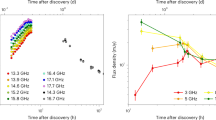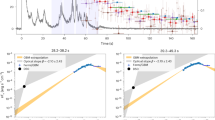Abstract
Now that γ-ray bursts (GRBs) have been determined to lie at cosmological distances1, their isotropic burst energies are estimated to be as high as 1054 erg (ref. 2), making them the most energetic phenomena in the Universe. The nature of the progenitors responsible for the bursts remains, however, elusive. The favoured models range from the merger of two neutron stars in a binary system3,4,5 to the collapse of a massive star6,7,8. Spectroscopic studies of the afterglow emission could reveal details of the environment of the burst, by indicating the elements present, the speed of the outflow and an estimate of the temperature. Here we report an X-ray spectrum of the afterglow of GRB011211, which shows emission lines of magnesium, silicon, sulphur, argon, calcium and possibly nickel, arising in metal-enriched material with an outflow velocity of the order of one-tenth the speed of light. These observations strongly favour models30 where a supernova explosion from a massive stellar progenitor precedes the burst event and is responsible for the outflowing matter.
This is a preview of subscription content, access via your institution
Access options
Subscribe to this journal
Receive 51 print issues and online access
$199.00 per year
only $3.90 per issue
Buy this article
- Purchase on Springer Link
- Instant access to full article PDF
Prices may be subject to local taxes which are calculated during checkout



Similar content being viewed by others
References
Metzger, M. R. et al. Spectral constraints on the redshift of the optical counterpart to the γ-ray burst of 8 May 1997. Nature 387, 878–880 (1997)
Meszaros, P. Theories of gamma-ray bursts. Preprint astro-ph/0111170 at 〈http://xxx.lanl.gov〉 (2001).
Paczynski, B. Gamma-ray bursters at cosmological distances. Astrophys. J. 308, L43–L46 (1986)
Eichler, D., Livio, M., Piran, T. & Schramm, D. N. Nucleosynthesis, neutrino bursts and γ-rays from coalescing neutron stars. Nature 340, 126–128 (1989)
Mochkovitch, R., Hernanz, M., Isern, J. & Martin, X. Gamma-ray bursts as collimated jets from neutron star/black hole mergers. Nature 361, 236–238 (1993)
Woosley, S. E. Gamma-ray bursts from stellar mass accretion disks around black holes. Astrophys. J. 405, 273–277 (1993)
Paczynski, B. Are gamma ray bursts in star-forming regions? Astrophys. J. 494, L45–L48 (1998)
Fryer, C. L., Woosley, S. E. & Hartmann, D. H. Formation rates of black hole accretion disk gamma-ray bursts. Astrophys. J. 526, 152–177 (1999)
Frontera, F. et al. GRB011211: BeppoSAX/GRBM data. GCN GRB Obs. Rep. No. 1215 (2001).
Fruchter, A. et al. GRB 011211: Spectroscopy of the optical counterpart. GCN GRB Obs. Rep. No. 1200 (2001).
Holland, S. et al. The optical afterglow of the gamma-ray burst GRB 011211. Astron J. (submitted); preprint astro-ph/0202309 at 〈http://xxx.lanl.gov〉 (2002).
Burud, I. et al. GRB 011211: Detection of the probable host galaxy. GCN GRB Obs. Rep. No. 1213 (2001).
Jansen, F. et al. XMM-Newton observatory. I. The spacecraft and operations. Astron. Astrophys. 365, L1–L6 (2001)
Santos-Lleo, M., Loiseau, N., Rodriguez, P., Altieri, B. & Schartel, N. GRB 011211: XMM-Newton observation of GRB011211. GCN GRB Obs. Rep. No. 1192 (2001).
Bevington, P. R. & Robinson, D. K. Data Reduction and Error Analysis for the Physical Sciences (McGraw-Hill, New York, 1992)
Mewe, R., Gronenschild, E. H. B. M. & van den Oord, G. H. J. Calculated X-radiation from optically thin plasmas. Astron. Astrophys. Suppl. 62, 197–254 (1985)
Ballantyne, D. R. & Ramirez-Ruiz, E. Iron Kα emission from X-ray reflection: Predictions for gamma-ray burst models. Astrophys. J. 559, L83–L87 (2001)
Kallman, T. R., Meszaros, P., Rees, M. J. Iron K lines from gamma ray bursts. Astrophys. J. (submitted); preprint astro-ph/0110654 at 〈http://xxx.lanl.gov〉 (2002).
Rees, M. J. & Meszaros, P. Fe Kα emission from a decaying magnetar model of gamma-ray bursts. Astrophys. J. 545, L73–L75 (2000)
Frail, D. A. et al. Beaming in gamma-ray bursts: Evidence for a standard energy reservoir. Astrophys. J. 562, L55–L58 (2001)
Piro, L. et al. Observation of X-ray lines from a gamma-ray burst (GRB991216): Evidence of moving ejecta from the progenitor. Science 290, 955–958 (2000)
Antonelli, L. A. et al. Discovery of a redshifted iron K line in the X-ray afterglow of GRB 000214. Astrophys. J. 545, L39–L42 (2000)
Piro, L. et al. Iron line signatures in X-ray afterglows of GRB by BeppoSAX. Astron. Astrophys. Suppl. 138, 431–432 (1999)
McLaughlin, G. C., Wijers, R. A. M. J., Brown, G. E. & Bethe, H. A. Broad and shifted iron-group emission lines in gamma-ray bursts as tests of the hypernova scenario. Astrophys. J. (submitted); preprint astro-ph/0110614 at 〈http://xxx.lanl.gov〉 (2001).
Weth, C., Meszaros, P., Kallman, T. & Rees, M. J. Early X-ray/ultraviolet line signatures of gamma-ray burst progenitors and hypernovae. Astrophys. J. 534, 581–586 (2000)
Wheeler, J. C., Yi, I., Hoeflich, P. & Wang, L. Asymmetric supernovae, pulsars, magnetars, and gamma-ray bursts. Astrophys. J. 537, 810–823 (2000)
Bulik, T., Belczynski, K. & Zbijewski, W. Distribution of compact object mergers around galaxies. Mon. Not. R. Astron. Soc. 309, 629–635 (1999)
Hanlon, L. et al. ISO detection of a 60 μm source near GRB 970508. Astron. Astrophys. 359, 941–947 (2000)
Bloom, J. S. et al. The unusual afterglow of the γ-ray burst of 26 March 1998 as evidence for a supernova connection. Nature 401, 453–456 (1999)
Vietri, M. & Stella, L. Supranova events from spun-up neutron stars: an explosion in search of an observation. Astrophys. J. 527, L43–L46 (1999)
Acknowledgements
This work is based on observations obtained with XMM-Newton, an ESA science mission with instruments and contributions directly funded by ESA Member States and the USA (NASA). We thank M. Rees, M. Davies, B. McBreen, R. Willingale and M. Barstow for critical reading of the manuscript, and for discussions.
Author information
Authors and Affiliations
Corresponding author
Ethics declarations
Competing interests
The authors declare that they have no competing financial interests.
Rights and permissions
About this article
Cite this article
Reeves, J., Watson, D., Osborne, J. et al. The signature of supernova ejecta in the X-ray afterglow of the γ-ray burst 011211. Nature 416, 512–515 (2002). https://doi.org/10.1038/416512a
Received:
Accepted:
Issue Date:
DOI: https://doi.org/10.1038/416512a
This article is cited by
-
A long-duration gamma-ray burst with a peculiar origin
Nature (2022)
-
On the pair-instability supernovae and gamma-ray burst phenomenon
Astrophysics and Space Science (2010)
Comments
By submitting a comment you agree to abide by our Terms and Community Guidelines. If you find something abusive or that does not comply with our terms or guidelines please flag it as inappropriate.



